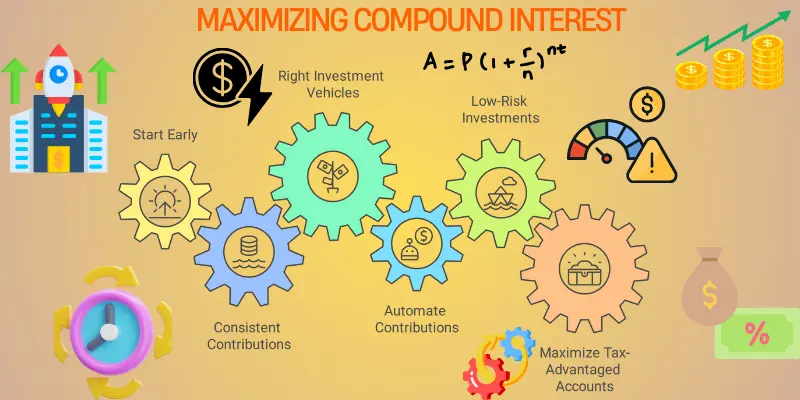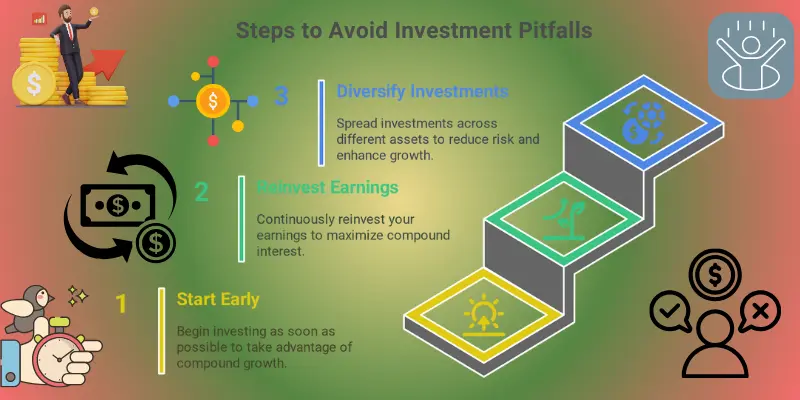The Power of Compound Interest: Why You Should Start Investing Early
Published: 27/03/2025
Have you ever wondered why some people seem to build wealth effortlessly while others struggle? It’s not magic—it’s the power of compound interest. In fact, if you start investing just $100 a month at age 25, by the time you’re 65, you could have over $640,000, assuming an average return of 10% annually. But what happens if you wait until you’re 35? To reach that same amount, you’d need to invest $200 a month instead. That’s the incredible difference starting early can make.
So, why do so many people delay investing, thinking they have plenty of time? The truth is, the earlier you start, the more time your money has to grow. In this post, we’ll break down how compound interest works, why starting early is key, and practical steps to get you on the right track.
Have you been putting off investing, thinking it’s too early to worry about? Let’s dive into why waiting might cost you—and how getting started now can set you up for financial success later. Keep reading!
| Key Highlights |
|---|
|
Your Money Multiplies Over Time: Compound interest fuels exponential growth, turning even small, consistent investments into substantial wealth over the years. Time Advantage: The earlier you start, the more powerful the compounding effect becomes. Financial Discipline: Regular, early investments build long-term wealth and instill sound financial habits. |
What is Compound Interest?
Compound interest is a type of interest that’s calculated not only on the initial amount you invest (the principal) but also on the interest that has already been added to your balance. It’s like earning interest on your interest. The more often it compounds, the faster your money grows!
How It Works:
To break it down, the formula for compound interest is:
A = P(1 + r/n)^(nt)
Where:
- A = the future value of the investment/loan, including interest
- P = the principal (initial investment)
- r = the annual interest rate (decimal)
- n = the number of times that interest is compounded per year
- t = the number of years the money is invested for
It sounds complicated, but don’t worry! The core idea is simple: the longer you leave your money to grow, the more interest it earns—making your money work harder for you.
Example:
Let’s say you invest $100 at a 5% interest rate for 5 years, compounded annually. After one year, you’d earn $5 in interest. But in year two, you earn interest on $105, not just your original $100. This snowball effect continues, and over time, your investment grows much faster than if you were only earning interest on the original amount. It’s like a snowball rolling down a hill, getting bigger and bigger as it goes!
Why Compound Interest is Powerful
Compound interest is powerful because it allows your money to grow at an accelerating rate, turning even small investments into significant sums over time with the magic of reinvested earnings.
Exponential Growth:
The magic of compound interest lies in its ability to grow your money exponentially. This means that small, consistent investments can turn into large sums over time. At first, the growth might seem slow, but as the interest compounds, the increase becomes faster and faster. It’s like planting a tree—early on, it’s just a small seed, but eventually, it grows into something huge, and the bigger it gets, the faster it spreads.
The Time Factor:
One of the biggest advantages of compound interest is that the earlier you start, the more you benefit. Starting early means your money has more time to grow and compound. It’s not just about the amount you invest; it’s about how long you let it sit and grow.
Example:
Let’s say you start investing at 20 vs. 30 years old.
- If you invest $1,000 at 7% annual interest, compounded yearly, for 40 years (starting at age 20), you’ll have around $14,974 by the time you’re 60.
- If you wait until you’re 30 and invest the same amount, it will grow to $7,612 by age 60.
Starting at 20 gives you more than double the return—just because you let your money compound for 10 extra years! It’s clear: time is your best friend when it comes to compound interest. The sooner you start, the less you need to invest to see impressive returns.
The Effects of Delaying Investment
Delaying investment can significantly reduce your potential returns, as you miss out on the compounding growth that builds over time, making it harder to achieve long-term financial goals.
Missed Opportunities:
Delaying your investment can mean missing out on huge opportunities for growth. Even waiting just a few years can result in significantly lower returns over time because you’re giving compound interest less time to work its magic. Every year you wait to invest is one more year your money isn’t growing.
The Cost of Procrastination:
Procrastination can be costly, especially when it comes to long-term financial goals like retirement. The longer you wait to invest, the more you’ll need to catch up later. A delay in starting your investment means more aggressive saving and investing in the future just to hit your target. Simply put, the earlier you start, the easier it is to reach those big financial milestones.
Example:
If you start saving for retirement at age 25 and contribute $200 per month at 7% annual return, you could have around $450,000 by the time you’re 60. But if you wait until age 35 to start, you’ll need to contribute over $400 per month to reach the same goal—almost double the amount! The cost of procrastination is real, and it often means working harder later to catch up.
How to Maximize Compound Interest
To maximize compound interest, start investing early, make consistent contributions, and choose investment options like stocks, bonds, or retirement accounts that allow your money to grow and compound over time.

Start Early:
The sooner you start investing, the more time your money has to grow through compound interest. Even if you’re starting with small amounts, getting the ball rolling early can lead to massive gains down the road.
Consistent Contributions:
Investing regularly, even in small amounts, is key to maximizing compound interest. Regular contributions keep your investment growing consistently, allowing your money to compound steadily over time.
Choosing the Right Investment Vehicles:
Certain investments are perfect for taking advantage of compound interest. Stocks, bonds, and retirement accounts like 401(k)s and IRAs all benefit from this powerful growth. These types of investments tend to provide returns that compound, making them ideal for long-term financial goals.
Example:
If you invest in a retirement account like a 401(k) or IRA, your contributions grow tax-deferred, meaning more of your money is working for you. Over decades, this can result in a much larger nest egg than if you were investing in accounts that don’t allow for this compounding benefit.
Practical Tips for Starting Early
To start early and make the most of compound interest, automate your contributions, begin with low-risk investments, and take advantage of tax-advantaged accounts like Roth IRAs or 401(k)s.
Setting Up Automated Contributions:
Automation is a game-changer—set up automatic transfers to your investment accounts, so you don’t have to think about it. It ensures you’re investing regularly, even if you forget or get busy.
Begin with Low-Risk Investments:
Starting with low-risk options like index funds or ETFs is a smart way to begin. These investments are beginner-friendly and provide steady returns with minimal risk, making them ideal for new investors.
Maximize Tax-Advantaged Accounts:
Take full advantage of tax-advantaged accounts like Roth IRAs or 401(k)s. These accounts allow your investments to grow without being taxed, letting compound interest work even harder for you over time.
Example:
By contributing to a Roth IRA, your money grows tax-free, and you can withdraw it tax-free in retirement, giving you a significant edge when it comes to compound interest.
Behavioral Finance: How to Avoid Common Pitfalls
To avoid common investment pitfalls, start early, reinvest your earnings, and diversify your investments to reduce risk and maximize compound growth.

Waiting Too Long to Start:
Delaying your investment by just a few years can mean missing out on significant compound growth, making it harder to reach your financial goals.
Not Reinvesting Earnings:
Cashing out your earnings instead of reinvesting them is a big mistake. Reinvesting your returns allows you to earn compound interest on those earnings, accelerating your wealth-building.
Not Diversifying Investments:
Putting all your money into one investment type, whether it’s stocks or bonds, is risky. Diversifying across different assets reduces risk and ensures your money is working in multiple ways to grow.
Example:
If you only invest in one stock and it drops, you could lose a large portion of your investment. But by diversifying across different stocks or asset classes, you spread the risk and increase your chances for stable growth.
Key Takeaways
- Compound interest is the foundation of long-term wealth.
- The earlier you invest, the less you need to invest to reach your financial goals.
- Automating investments and taking advantage of tax-advantaged accounts help maximize compound interest.
Fun Facts About Compound Interest
- Einstein’s Favorite Wonder:
Albert Einstein once called compound interest “the most powerful force in the universe.” And honestly, who are we to argue with one of history’s greatest minds? - The Snowball Effect:
Compound interest works like a snowball rolling down a hill. At first, it’s slow, but as it gathers momentum, it grows much faster and bigger over time! - Early Investors Get a Bonus:
If you started investing $100 a month at age 20, by the time you’re 60, you’d have more than $450,000—just by doing nothing but letting compound interest do its thing. Imagine that as your “lazy” money! - A Tale of Two Savers:
If you invest $1,000 at 7% interest, compounded annually, starting at age 20, you’ll have almost 5 times more by age 60 than if you started at age 30. So, in a way, time really is money! - The 8th Wonder of the World:
It’s often said that compound interest is the 8th wonder of the world. And why not? It works behind the scenes to make your money grow—faster than you may think. - It’s Like a Plant:
Think of your investments as seeds. Compound interest is the sunlight that helps them grow. The earlier you plant them, the bigger they’ll get when it’s time to harvest!
Conclusion
Here’s a quick recap of why starting early and leveraging compound interest is so powerful:
- Start Early: The sooner you begin, the more time your money has to grow exponentially through compound interest.
- Time is Your Greatest Asset: The longer you wait, the harder it becomes to catch up, so don’t delay!
- Consistent Contributions Matter: Small, regular investments add up over time, making a big difference in the long run.
- Smart Choices: Opt for tax-advantaged accounts and low-risk investments to give your money the best chance to grow.
Remember, the biggest mistakes are waiting too long to start, not reinvesting your earnings, and failing to diversify your investments. These can all prevent you from unlocking the true power of compound interest.
Start today, no matter how small! The earlier you invest, the more time your money has to grow. Subscribe for more tips, leave a comment about your investment journey, and share this article with someone who needs a little financial motivation!
Time is the most powerful tool in investing, and compound interest is the engine that drives it. Don’t let procrastination rob you of your financial future—start now and let your money work for you!
FAQs: The Power of Compound Interest
There’s no minimum amount, but the earlier and more consistently you invest, the better. Even small amounts add up over time, especially if you invest regularly.
Simple interest is calculated only on the principal amount, while compound interest is calculated on the principal and the accumulated interest, making compound interest grow your money faster over time.
Yes! Even small investments can grow significantly over time with compound interest, especially if you start early and contribute regularly.
Start investing as soon as possible, even if it’s a small amount. Setting up automatic contributions to an investment account can help you invest regularly without much effort.
While compound interest helps your investments grow over time, you can lose money if your investments decline in value (e.g., in stocks). It’s important to invest in diversified assets and stick to your long-term plan to manage risk.
Yes, you can still benefit from compound interest if you start later, but the earlier you start, the more you benefit from the power of compounding. Starting later means you’ll need to invest more money to achieve the same long-term growth.

- Be Respectful
- Stay Relevant
- Stay Positive
- True Feedback
- Encourage Discussion
- Avoid Spamming
- No Fake News
- Don't Copy-Paste
- No Personal Attacks

- Be Respectful
- Stay Relevant
- Stay Positive
- True Feedback
- Encourage Discussion
- Avoid Spamming
- No Fake News
- Don't Copy-Paste
- No Personal Attacks





